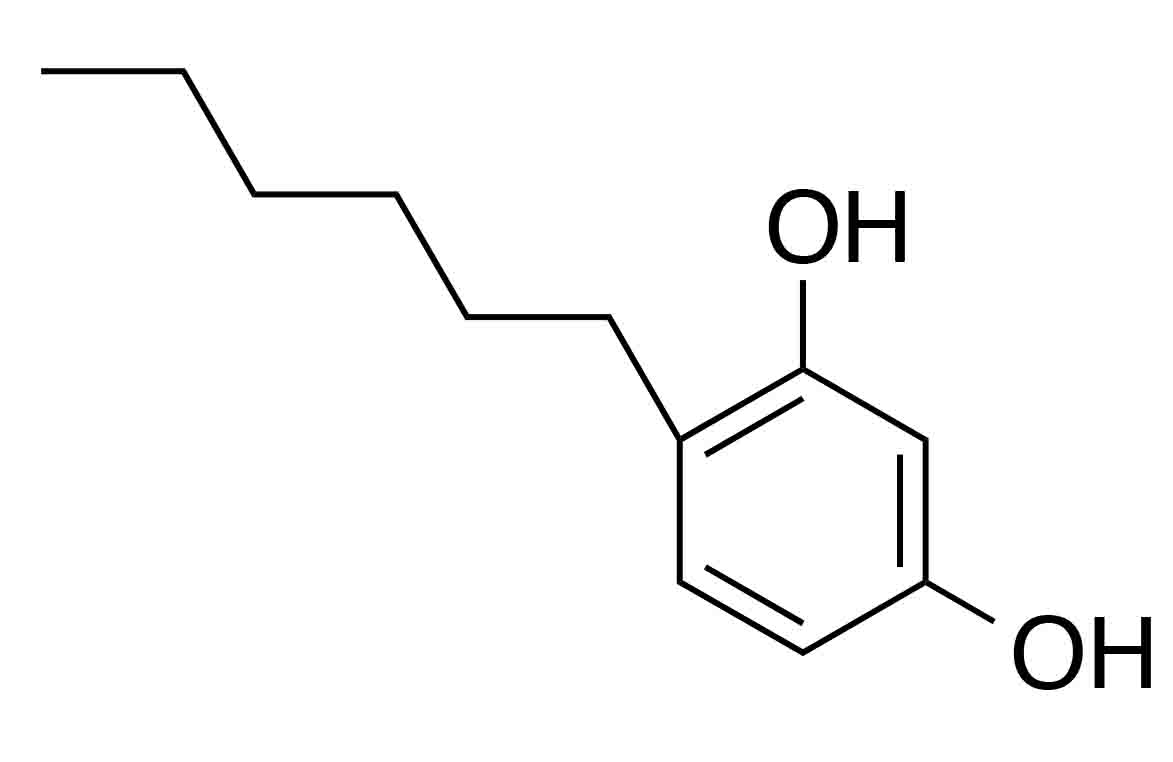


INCI name: hexylresorcinol
Synonyms: 4-hexylresorcinol; 1,3-dihydroxy-4-hexylbenzene, 4-hexyl-1,3-benzenediol, 4-hexyl-1,3-dihydroxybenzene, and 4-hexylresorcine.
Molecular formula: C12H18O2
Molecular weight: 194.27 g/mol
IUPAC name: 4-hexylbenzene-1,3-diol
CAS number: 136-77-6
EINECS number: 205-257-4
Hexylresorcinol is an alkylresorcinol, a type of amphiphilic phenolic lipid having an n-hexyl chain attached to the 4 position of the 1,3-dihydroxybenzene ring. Alkylresorcinols provide benefits in a wide range of applications (antibacterial, antiparasitic, anesthetic, antiseptic, etc.) due to the interactions of their alkyl chains with phospholipids and/or proteins and to the antioxidant activity of the phenolic hydroxyl group.1
Despite hexylresorcinol’s long history of use in foods and pharmaceuticals it is only recently that its benefits in skin care preparations has been realized. Its primary use in skin care products is as a skin lightening agent and to control hyperpigmentation.2 Its mechanism of action in skin is by modulating multiple sites in the melanogenesis pathway, namely inhibition of tyrosinase and peroxidase enzyme activities, as well as stimulating antioxidant activity (e.g., glutathione, glutathione peroxidase, and glutathione reductase).3
Properties
Solubility: >20% solubility in a wide range of hydrophobic emollients and solubilizers, isosorbide dicaprylate, and low molecular weight glycols.4 Also, soluble in ether and acetone; and slightly soluble in water.5
Melting point: 64-69 °C6
pKa: 10.035
Boiling point: 333-335 °C5
Log P (exp): 3.885
References
1. A. Kozubek and J.H.P. Tyman, Resorcinolic lipids, the natural nonisoprenoid phenolic amphiphiles and their biologic activity, Chem. Rev., 99, 1-25 (1999).
2. R.K. Chaudhuri, “Hexylresorcinol: providing skin benefits by modulating multiple molecular targets” in Cosmeceuticals and Active Cosmetics, 3rd ed., Eds. R.K. Sivamani, J.R. Jagdeo, P. Elsner, and H.I. Maibach, 71-82 (2015).
3.
G.C. Yen, P.D. Duh, and C.W. Lin, Effects of resveratrol and 4-hexylresorcinol on hydrogen peroxide-induced oxidative DNA damage in human lymphocytes, Free Rad. Res., 37(5), 509-514 (2003).
4. Synovea® HR Product Brochure, Sytheon Ltd. (2016).
5. European Food Safety Authority (EFSA), Parma, Italy, Scientific Opinion on the re-evaluation of 4-hexylresorcinol (E 586) as a food additive, EFSA Journal, 12(4), 3643 (2014).
6. Certificate of analysis,
Synovea® HR Hexylresorcinol, Sytheon Ltd., March 2015.